Culligan Iron-Cleer User Manual
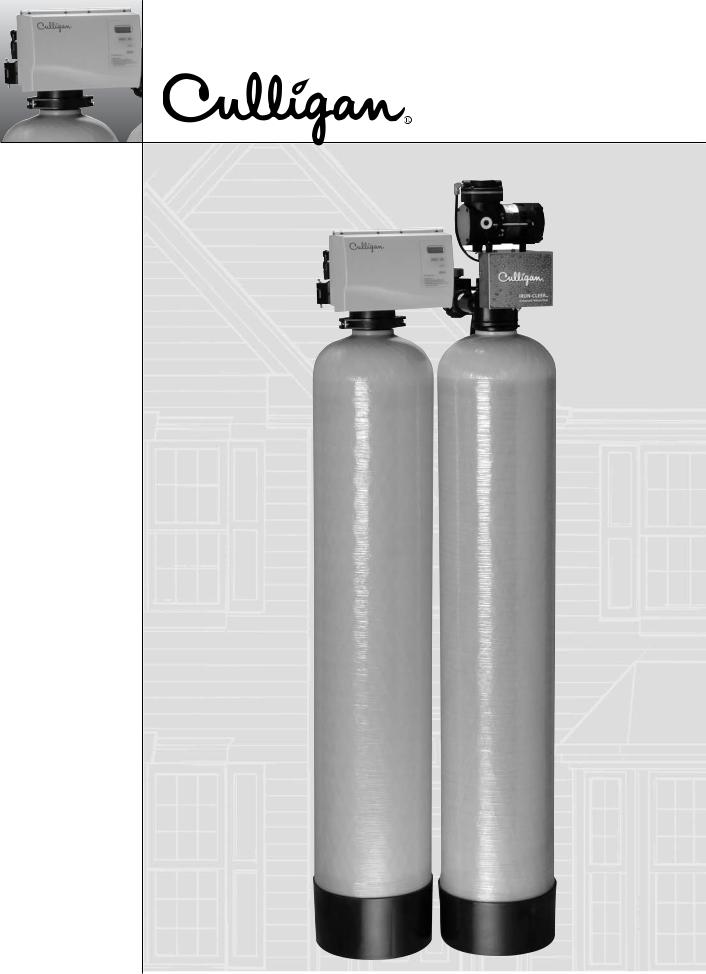
Culligan®
Iron-Cleer®
Automatic
Water Filter
Owners Guide
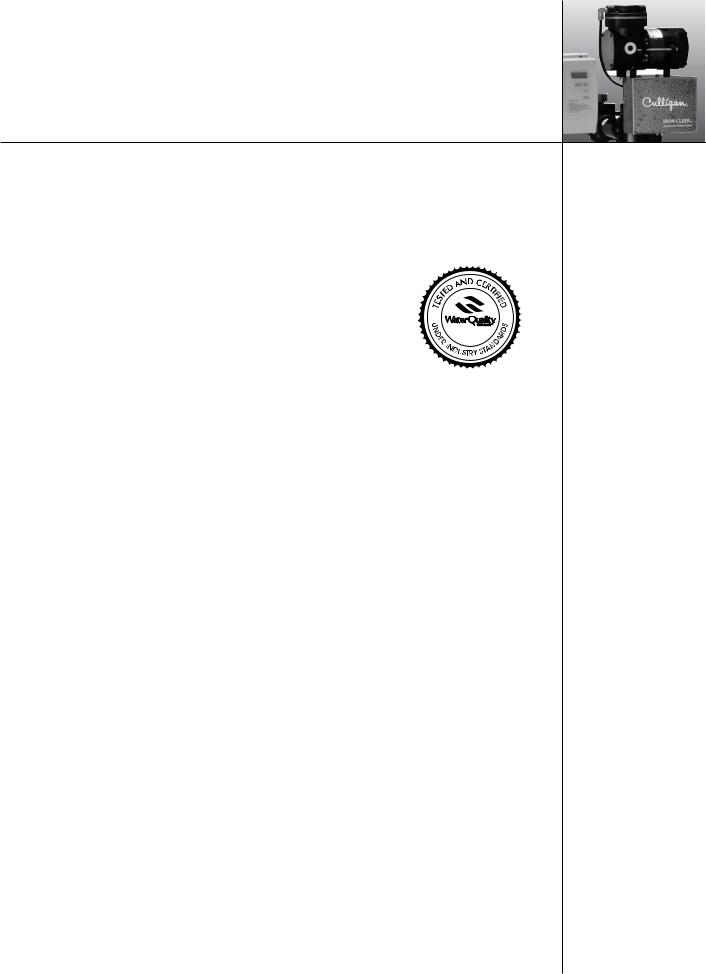
THANK YOU
AND WELCOME TO YOUR NEW WORLD OF BETTER
LIVING WITH CULLIGAN WATER.
The Culligan® Iron Cleer® water filters have been tested and certified by WQA against WQA-200 for the effective reduction of iron up to 1,400 gallons for 10” units and 2,000 gallons for 12” units.
Do not use with water that is microbiologically unsafe or of unknown quality without adequate disinfection before or after the system.
This system and its installation must comply with state and local regulations. The System is ONLY to be supplied with cold water.
For installations in Massachusetts, the Commonwealth of Massachusetts Plumbing Code 248 CMR shall be adhered to. Consult your licensed plumber for installation of the system. This system and its installation must comply with state and local regulations. The use of saddle valves are not permitted.
If this is your first experience having filtered, conditioned water in your home, you’ll be amazed at the marvelous difference it makes. We promise that you’ll never want to be without it again.
Congratulations, too, on selecting one of the “first family” of water filters in the prestigious Culligan Iron-Cleer. With Culligan’s many years of knowledge and experience in water treatment, you can be confident that the model you selected has been designed and engineered to provide years of service with a minimum of care and attention.
Products manufactured and marketed by Culligan International Company (Culligan) and its affiliates are protected by patents issued or pending in the United States and other countries. Culligan reserves the right to change the specifications referred to in this literature at any time, without prior notice. Culligan, Culligan Iron-Cleer, Cullar, Filtr-Cleer, Cullneu, Accusoft, Culligan Man and www. culligan.com are trademarks of Culligan International Company or its affiliates.
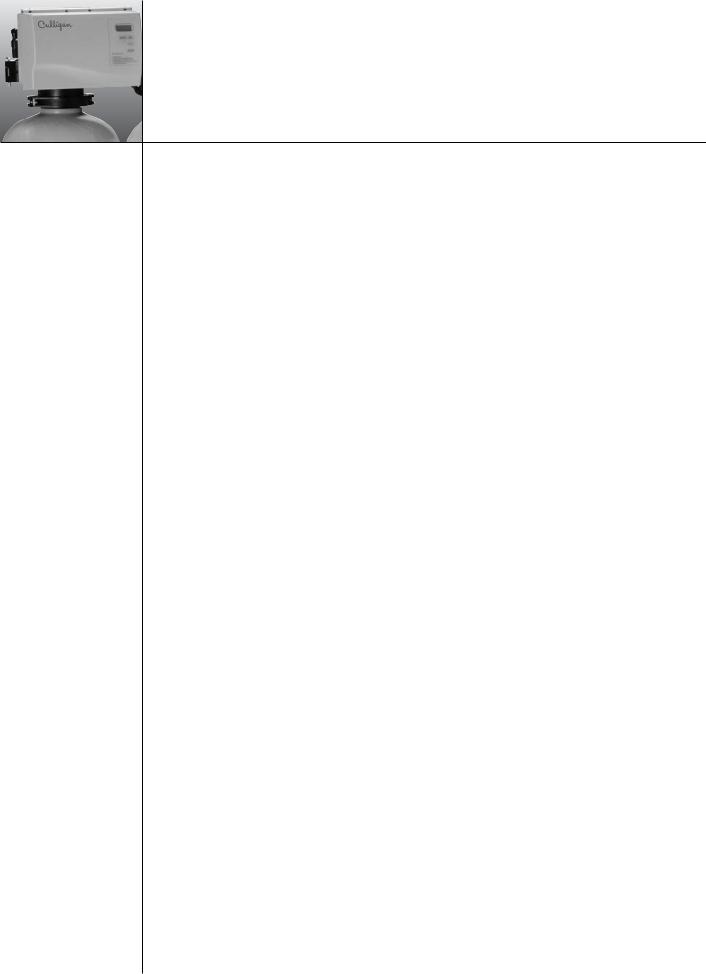
Table of
Contents
Specifications . . . . . . . . . . . . . . . . . . . . . . . . . . . 1 Introduction . . . . . . . . . . . . . . . . . . . . . . . . . . . . 2 Operating Conditions . . . . . . . . . . . . . . . . . . . . . . . . 4 Familiarization . . . . . . . . . . . . . . . . . . . . . . . . . . . 5 Programming . . . . . . . . . . . . . . . . . . . . . . . . . . . 6 When and How to Bypass your Water Filter . . . . . . . . . . . . . . . 8 Things to Check Before You Call for Service . . . . . . . . . . . . . . 10 Care and Cleaning of your water conditioner . . . . . . . . . . . . . . 11 Preventative Maintenance . . . . . . . . . . . . . . . . . . . . . 12 Troubleshooting Guide . . . . . . . . . . . . . . . . . . . . . . . 13 Performance Data Sheet . . . . . . . . . . . . . . . . . . . . . . 16 Records and Data . . . . . . . . . . . . . . . . . . . . . . . . . 17 Warranty . . . . . . . . . . . . . . . . . . . . . . . . . . . . 18
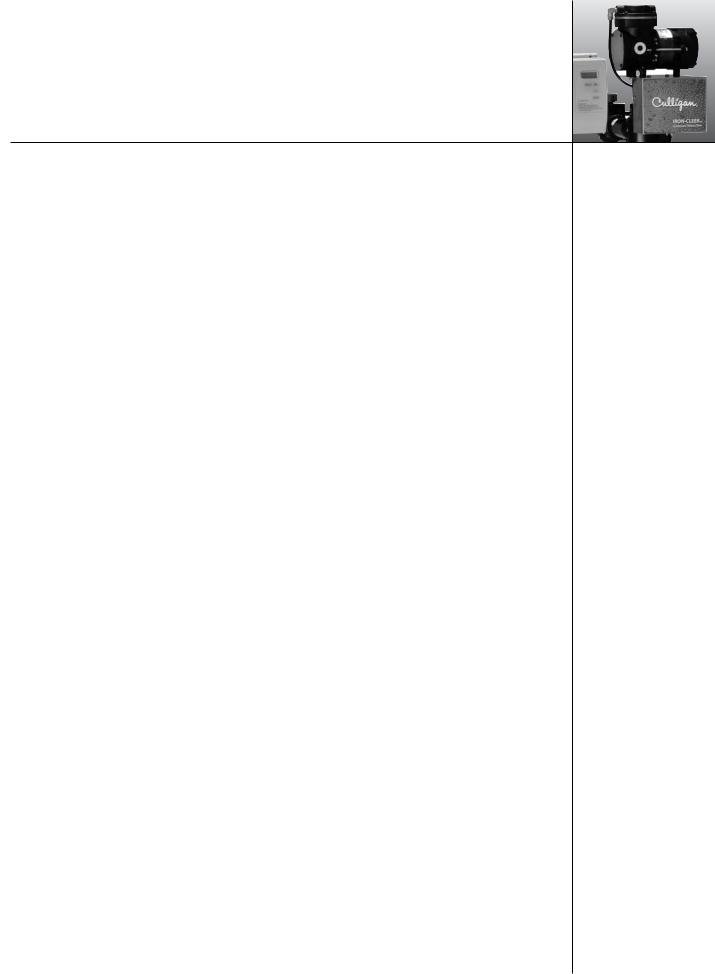
Culligan® Iron Cleer® Filters |
|
|
|
|
|
|
Specifications |
||
|
|
|
|
|
|
10” Iron Cleer |
12” Iron Cleer |
|
|
|
|
|
|
|
Control Valve |
1” 5-cycle reinforced |
1” 5-cycle reinforced |
|
|
thermoplastic |
thermoplastic |
|
|
|
|
|
|
||
Timer |
Electro-mechanical |
Electro-mechanical |
|
|
|
|
|
|
|
Overall Conditioner Height |
67” |
65” |
|
|
|
|
|
|
|
Media Tank Dimensions (D |
2 ea. 10” x 54” tanks |
2 ea. 12” x 52” tanks |
|
|
x H) |
|
|
||
|
|
|
|
|
Filter Media Type |
1.0 cu. ft. birm |
1.5 cu. ft. birm |
|
|
|
|
|
|
|
Underbedding |
|
|
|
|
|
|
|
|
|
G-50 |
35 lbs. |
35 lbs. |
|
|
|
|
|
|
|
Cullsan U |
25 lbs. |
25 lbs. |
|
|
|
|
|
|
|
Capacity1 |
1400 gallons |
2000 gallons |
|
|
Freeboard2 |
21” |
18” |
|
|
Max. Clear Water (Soluble) |
10 ppm |
10 ppm |
|
|
Iron |
|
|||
|
|
|
|
|
Max. Hydrogen Sulfide |
5.0 ppm |
5.0 ppm |
|
|
|
|
|
|
|
Minimum Alkalinity |
100 ppm |
100 ppm |
|
|
|
|
|
|
|
pH |
7.0 - 8.5 |
7.0 - 8.5 |
|
|
|
|
|
|
|
Service Flow @ Pressure Drop (Clean Bed) |
|
|
|
|
|
|
|
|
|
Normal |
5 gpm @ 9 psi |
7 gpm @ 10 psi |
|
|
|
|
|
|
|
Maximum3 |
6 gpm @ 9 psi |
9 gpm @ 14 psi |
|
|
Operating Pressure |
20-60 psi |
20-60 psi |
|
|
|
|
|
|
|
Operating Temperature |
33-120° F (1-48° C) |
33-120° F (1-48° C) |
|
|
|
|
|
|
|
Electrical Requirements |
120 Volts/60 Hz |
120 Volts/60 Hz |
|
|
|
|
|
|
|
Power Consumption, |
3 watts/203 watts |
3 watts/203 watts |
|
|
Continuous/Maximum |
|
|||
|
|
|
|
|
Drain Flow, Maximum |
10 gpm (5.5 gpm min. required) |
10 gpm (8.0 gpm min. required) |
|
|
|
|
|
|
|
Regeneration Time |
|
|
|
|
|
|
|
|
|
Backwash |
5 - 20 minutes |
5 - 20 minutes |
|
|
|
|
|
|
|
Fast Rinse |
5 - 20 minutes |
5 - 20 minutes |
|
|
|
|
|
|
|
1Capacity based on 4 gpm and 10 mg/L of dissolved iron.
2Measured from top of media bed to top of inlet fitting.
3Max flow rates & pressure drop characteristics have not been validated by the Water Quality Association.
The max specified flow rate at which the system will deliver treated water as validated by the Water
Quality Association is defined as service flow.

Introduction Operation
Step 1.
Aeration Operation Service Cycle
In the service cycle, raw water enters the inlet port of the aeration tank and is directed through the inlet diffuser. The oxidation process begins when the water passes through the inlet diffuser and cascades through a head of air. This air/ water contact oxidizes the iron, manganese, hydrogen sulfide in the water. The water is directed toward the bottom of the tank and travels through the pickup tube. It then passes through the outlet of the aeration tank to the inlet of the filter tank.
Filter Tank Operation Service Cycle
Raw water enters the filter tank through the inlet port of the filter control valve. Upon system demand for filtered water, water is directed to the top of the tank and flows downward through the multimedia filter bed toward the lower distributor. Oxidized iron particles are trapped by the filter bed as the water passes through. Filtered water enters the lower distributor and travels up the distributor tube to the outlet port on the filter valve.
Step 2.
Aeration Operation Air Recharge Cycle
When energized, the air pump sends air through the solenoid valve into one end of the shuttle valve. Once air pressure in the shuttle valve is greater than the water supply pressure at the other end
of the shuttle valve, the piston shifts to the open position. In the open position, the bleed-off port discharges excess water and old air to the drain port through a flow restrictor. Simultaneously, the air inlet port opens to provide a direct connection between the air pump and the top of the aeration tank. The air pump runs for a preset period of time recharging the head of air in the aeration tank.
Air Recharge Shut Off
The timer turns power off to the air pump and the solenoid valve at the end of the recharge cycle. The solenoid valve then closes the port between the air pump and the shuttle valve. The port between the shuttle valve and the atmosphere opens and releases air pressure. This allows water pressure to shift the piston to the closed position. With the piston in the closed position, the air recharge inlet port is closed and direct communication between the bleed off tube and the drain port is also closed.
Timer Operation
A timer controls the air recharge cycle and how frequently it occurs. The timer simultaneously energizes the air pump and the solenoid valve. After a preset amount of time, the timer shuts off the air pump and de-energizes the solenoid valve.
Solenoid Valve Operation
The solenoid valve is a three-way valve having ports that connect to the air pump, shuttle valve and the atmosphere. In the service cycle, the solenoid valve is de-energized and closes the port to the air pump, providing a positive shut-off to the pump. This prevents water from backing up into the air pump and damaging the pump. In the air recharge cycle, the solenoid valve closes the port to the atmosphere and opens the port from the air pump.
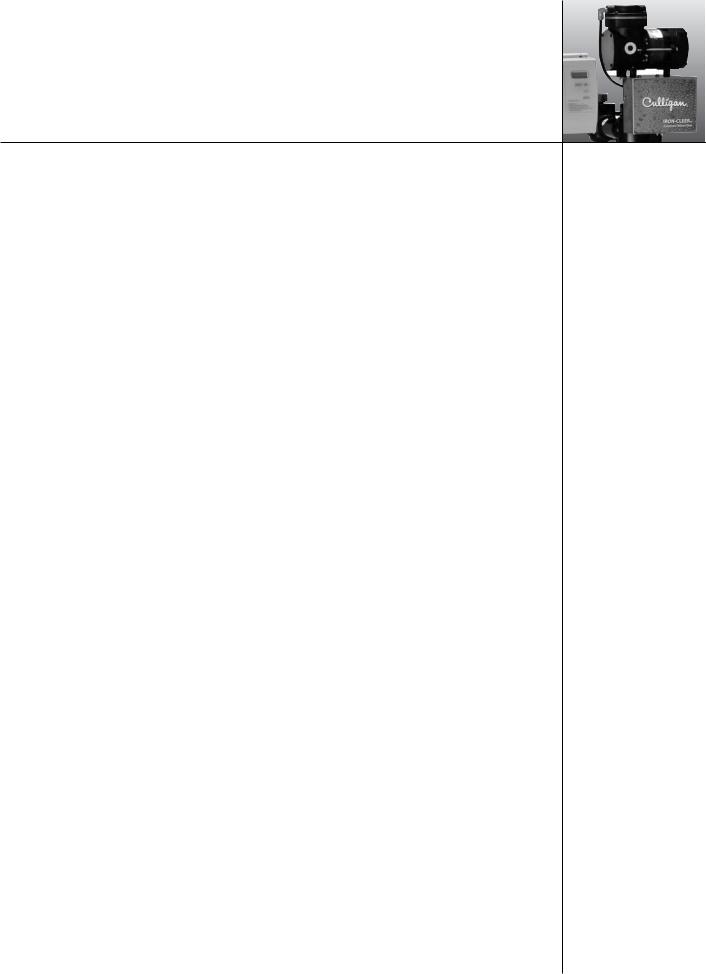
Shuttle Valve Operation
In the service position, water pressure holds the shuttle valve piston in the closed position, trapping the airhead in the aeration tank and closes the air recharge inlet port and drain port. During air recharge cycle, air pressure is greater than the water pressure and forces the shuttle valve piston in the open piston. The shuttle valve has an internal pressure relief valve that will relieve pressure (greater than 100 psi) that may build up in the aeration tank. This precautionary function protects components from failure due to excessive pressure.
Step 3.
Filter Tank Operation - Backwash Cycle
Reversing the flow of water through the filter bed and backwashing dirty water to the drain cleans the filter bed. Raw water enters the filter control valve through the inlet port and is directed down the distributor tube and out the lower distributor at the bottom of the tank, flowing upward through the multimedia filter bed toward the top of the tank into the control valve. Water is then directed through a specific flow restrictor and out the drain port to be discharged to drain.
Step 4.
Filter Tank Operation - Rinse Cycle
The rinse cycle packs the clean filter bed. Raw water enters the control valve through the inlet port and is directed downward through the filter bed into the bottom distributor, up the distributor tube into the control valve. Water is then directed through a specific flow restrictor and out the drain port to be discharged to drain.
Operation Of Aeration Pump
The Iron-Cleer™ system introduces air into the aeration tank and bleeds off the old head of air automatically. The exchange of the air into the aeration tank is controlled independently of the recharge frequency of the filter media tank, allowing the air to be exchanged on a more frequent basis. During an air exchange cycle, the air compressor pumps fresh air into the aeration tank and the air eliminator solenoid exhausts the old air.
Advantages Over Other Systems
1.No chemicals or salt.
2.No air injectors, venturis, or micronizers.
3.No floats to regulate air volume in aeration tank which “foul” from iron.
4.Two-tank system consisting of a pressurized aeration tank and multi-media depth filter.
5.110V aeration pump to recharge aeration tank.
6.Can be used on shared wells, municipal water supplies or with buried pressure tanks without additional equipment.
7.Better filtration results.
